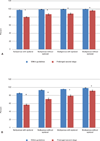Neonatal and maternal outcomes with prolonged second stage of labor
- PMID: 24901265
- PMCID: PMC4065200
- DOI: 10.1097/AOG.0000000000000278
Neonatal and maternal outcomes with prolonged second stage of labor
Erratum in
- Obstet Gynecol. 2014 Oct;124(4):842
Abstract
Objective: To assess neonatal and maternal outcomes when the second stage of labor was prolonged according to American College of Obstetricians and Gynecologists guidelines.
Methods: Electronic medical record data from a retrospective cohort (2002-2008) from 12 U.S. clinical centers (19 hospitals), including 43,810 nulliparous and 59,605 multiparous singleton deliveries at 36 weeks of gestation or greater, vertex presentation, who reached 10-cm cervical dilation were analyzed. Prolonged second stage was defined as: nulliparous women with epidural greater than 3 hours and without greater than 2 hours and multiparous women with epidural greater than 2 hours and without greater than 1 hour. Maternal and neonatal outcomes were compared and adjusted odds ratios calculated controlling for maternal race, body mass index, insurance, and region.
Results: Prolonged second stage occurred in 9.9% and 13.9% of nulliparous and 3.1% and 5.9% of multiparous women with and without an epidural, respectively. Vaginal delivery rates with prolonged second stage compared with within guidelines were 79.9% compared with 97.9% and 87.0% compared with 99.4% for nulliparous women with and without epidural, respectively, and 88.7% compared with 99.7% and 96.2% compared with 99.9% for multiparous women with and without epidural, respectively (P<.001 for all comparisons). Prolonged second stage was associated with increased chorioamnionitis and third-degree or fourth-degree perineal lacerations. Neonatal morbidity with prolonged second stage included sepsis in nulliparous women (with epidural: 2.6% compared with 1.2% [adjusted odds ratio (OR) 2.08, 95% confidence interval (CI) 1.60-2.70]; without epidural: 1.8% compared with 1.1% [adjusted OR 2.34, 95% CI 1.28-4.27]); asphyxia in nulliparous women with epidural (0.3% compared with 0.1% [adjusted OR 2.39, 95% CI 1.22-4.66]) and perinatal mortality without epidural (0.18% compared with 0.04% for nulliparous women [adjusted OR 5.92, 95% CI 1.43-24.51]); and 0.21% compared with 0.03% for multiparous women (adjusted OR 6.34, 95% CI 1.32-30.34). However, among the offspring of women with epidurals whose second stage was prolonged (3,533 nulliparous and 1,348 multiparous women), there were no cases of hypoxic-ischemic encephalopathy or perinatal death.
Conclusions: Benefits of increased vaginal delivery should be weighed against potential small increases in maternal and neonatal risks with prolonged second stage.
Level of evidence: : II.
Conflict of interest statement
Figures


Similar articles
-
The impact of extending the second stage of labor to prevent primary cesarean delivery on maternal and neonatal outcomes.Am J Obstet Gynecol. 2019 Feb;220(2):191.e1-191.e7. doi: 10.1016/j.ajog.2018.10.028. Epub 2018 Oct 25. Am J Obstet Gynecol. 2019. PMID: 30616966
-
Randomized controlled trial of prolonged second stage: extending the time limit vs usual guidelines.Am J Obstet Gynecol. 2016 Mar;214(3):361.e1-6. doi: 10.1016/j.ajog.2015.12.042. Am J Obstet Gynecol. 2016. PMID: 26928148 Clinical Trial.
-
Maternal and neonatal outcomes of prolonged second stage of labor with delayed pushing: A study of French Perinatal practices before and after guideline changes.Eur J Obstet Gynecol Reprod Biol. 2025 Jan;304:63-69. doi: 10.1016/j.ejogrb.2024.11.010. Epub 2024 Nov 22. Eur J Obstet Gynecol Reprod Biol. 2025. PMID: 39580909
-
Prolonged Second Stage: What Is the Optimal Length?Obstet Gynecol Surv. 2016 Nov;71(11):667-674. doi: 10.1097/OGX.0000000000000368. Obstet Gynecol Surv. 2016. PMID: 27901551 Review.
-
Second stage of labor.Clin Obstet Gynecol. 2015 Jun;58(2):227-40. doi: 10.1097/GRF.0000000000000113. Clin Obstet Gynecol. 2015. PMID: 25851851 Review.
Cited by
-
Associations between prolonged second stage of labor and maternal and neonatal outcomes in freestanding birth centers: a retrospective analysis.BMC Pregnancy Childbirth. 2022 Feb 4;22(1):99. doi: 10.1186/s12884-022-04421-8. BMC Pregnancy Childbirth. 2022. PMID: 35120470 Free PMC article.
-
Determinants of birth asphyxia among live birth newborns in University of Gondar referral hospital, northwest Ethiopia: A case-control study.PLoS One. 2018 Sep 7;13(9):e0203763. doi: 10.1371/journal.pone.0203763. eCollection 2018. PLoS One. 2018. PMID: 30192884 Free PMC article.
-
Prolonged passive second stage of labor in nulliparous women-Prevalence and risk factors: A historical cohort study.Acta Obstet Gynecol Scand. 2022 May;101(5):499-505. doi: 10.1111/aogs.14342. Epub 2022 Mar 16. Acta Obstet Gynecol Scand. 2022. PMID: 35293611 Free PMC article.
-
Effect of Immediate vs Delayed Pushing on Rates of Spontaneous Vaginal Delivery Among Nulliparous Women Receiving Neuraxial Analgesia: A Randomized Clinical Trial.JAMA. 2018 Oct 9;320(14):1444-1454. doi: 10.1001/jama.2018.13986. JAMA. 2018. PMID: 30304425 Free PMC article. Clinical Trial.
-
The single pregnancy predicting model of 1 minute Apgar score less than 7 after preterm birth: A retrospective study.PLoS One. 2022 Dec 22;17(12):e0279385. doi: 10.1371/journal.pone.0279385. eCollection 2022. PLoS One. 2022. PMID: 36548293 Free PMC article.
References
-
- Hellman LM, Prystowsky H. The duration of the second stage of labor. Am J Obstet Gynecol. 1952 Jun;63(6):1223–1233. - PubMed
-
- Cohen WR. Influence of the duration of second stage labor on perinatal outcome and puerperal morbidity. Obstet Gynecol. 1977 Mar;49(3):266–269. - PubMed
-
- Moon JM, Smith CV, Rayburn WF. Perinatal outcome after a prolonged second stage of labor. J Reprod Med. 1990 Mar;35(3):229–231. - PubMed
Publication types
MeSH terms
Grants and funding
LinkOut - more resources
Full Text Sources
Other Literature Sources
Medical
Molecular Biology Databases
Research Materials
